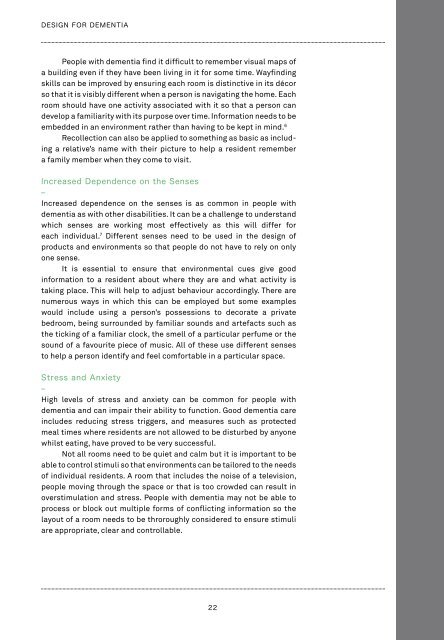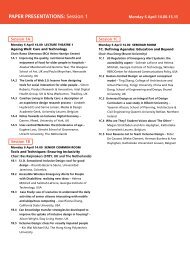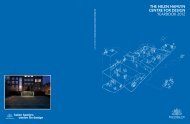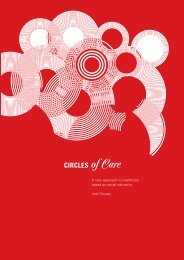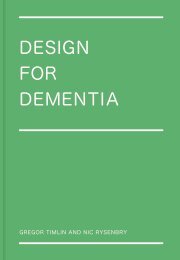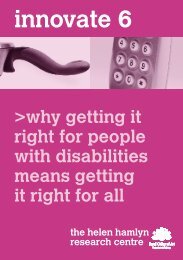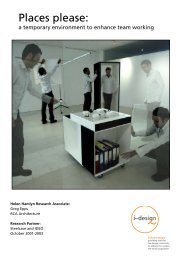Design for Dementia - Helen Hamlyn Centre - Royal College of Art
Design for Dementia - Helen Hamlyn Centre - Royal College of Art
Design for Dementia - Helen Hamlyn Centre - Royal College of Art
You also want an ePaper? Increase the reach of your titles
YUMPU automatically turns print PDFs into web optimized ePapers that Google loves.
DESIGN FOR DEMENTIA<br />
CONTEXT<br />
People with dementia find it difficult to remember visual maps <strong>of</strong><br />
a building even if they have been living in it <strong>for</strong> some time. Wayfinding<br />
skills can be improved by ensuring each room is distinctive in its décor<br />
so that it is visibly different when a person is navigating the home. Each<br />
room should have one activity associated with it so that a person can<br />
develop a familiarity with its purpose over time. In<strong>for</strong>mation needs to be<br />
embedded in an environment rather than having to be kept in mind. 6<br />
Recollection can also be applied to something as basic as including<br />
a relative’s name with their picture to help a resident remember<br />
a family member when they come to visit.<br />
Increased Dependence on the Senses<br />
–<br />
Increased dependence on the senses is as common in people with<br />
dementia as with other disabilities. It can be a challenge to understand<br />
which senses are working most effectively as this will differ <strong>for</strong><br />
each individual. 7 Different senses need to be used in the design <strong>of</strong><br />
products and environments so that people do not have to rely on only<br />
one sense.<br />
It is essential to ensure that environmental cues give good<br />
in<strong>for</strong>mation to a resident about where they are and what activity is<br />
taking place. This will help to adjust behaviour accordingly. There are<br />
numerous ways in which this can be employed but some examples<br />
would include using a person’s possessions to decorate a private<br />
bedroom, being surrounded by familiar sounds and artefacts such as<br />
the ticking <strong>of</strong> a familiar clock, the smell <strong>of</strong> a particular perfume or the<br />
sound <strong>of</strong> a favourite piece <strong>of</strong> music. All <strong>of</strong> these use different senses<br />
to help a person identify and feel com<strong>for</strong>table in a particular space.<br />
Stress and Anxiety<br />
–<br />
High levels <strong>of</strong> stress and anxiety can be common <strong>for</strong> people with<br />
dementia and can impair their ability to function. Good dementia care<br />
includes reducing stress triggers, and measures such as protected<br />
meal times where residents are not allowed to be disturbed by anyone<br />
whilst eating, have proved to be very successful.<br />
Not all rooms need to be quiet and calm but it is important to be<br />
able to control stimuli so that environments can be tailored to the needs<br />
<strong>of</strong> individual residents. A room that includes the noise <strong>of</strong> a television,<br />
people moving through the space or that is too crowded can result in<br />
overstimulation and stress. People with dementia may not be able to<br />
process or block out multiple <strong>for</strong>ms <strong>of</strong> conflicting in<strong>for</strong>mation so the<br />
layout <strong>of</strong> a room needs to be throroughly considered to ensure stimuli<br />
are appropriate, clear and controllable.<br />
Prospective Memory<br />
–<br />
Memory is not just about remembering what has happened but also about remembering what<br />
will happen. Prospective memory or planning memory is about remembering and maintaining<br />
future aims as well as recalling what is needed to reach that aim.<br />
For people with dementia, the ability to remember future events is lessened. It has been<br />
suggested that this is one <strong>of</strong> the reasons why people may seldom do things under their own<br />
initiative. 8 Opportunities must be provided to keep people active and socially engaged and<br />
ensure that they do not become apathetic or depressed.<br />
–<br />
6. John Zeisel,<br />
Environmental<br />
Neuroscience and<br />
Alzheimer’s Disease.<br />
In Alzheimer’s Care<br />
Quarterly, October-<br />
December 2005, p5<br />
–<br />
7. Mary Marshall,<br />
Food Glorious Food;<br />
Perspectives on Food<br />
and <strong>Dementia</strong>, Hawker<br />
Publications, 2003, p12<br />
–<br />
8. Grethe Berg, The<br />
Importance <strong>of</strong> Food and<br />
Mealtimes in <strong>Dementia</strong><br />
Care, Athenaeum Press,<br />
Great Britain, 2002, p26.<br />
SOCIAL<br />
Environments should create opportunities <strong>for</strong> a good level <strong>of</strong> social<br />
interaction between staff and residents. This is important <strong>for</strong> both the<br />
well being <strong>of</strong> the residents and the job satisfaction <strong>of</strong> the staff.<br />
Doing Tasks Together<br />
–<br />
With dementia, per<strong>for</strong>ming tasks that require a lot <strong>of</strong> steps<br />
can be very difficult as this involves a complex process<br />
termed ‘executive functioning’. In a task such as dressing,<br />
a person will have to plan what they intend to wear, initiate<br />
the process <strong>of</strong> putting on clothes, monitor that they<br />
are putting them on in the correct order, perhaps take<br />
corrective action and finally verify they have completed<br />
what they started. Tasks that require sequences <strong>of</strong><br />
in<strong>for</strong>mation become more incomprehensible from the mid<br />
stages <strong>of</strong> dementia onwards.<br />
Although it is impossible to restore a person’s ability<br />
to do such tasks independently, once that ability has been<br />
lost carers can take the time to remind them <strong>of</strong> sequences<br />
they have <strong>for</strong>gotten. This allows people to re-access<br />
activities and reconnect with them.<br />
Procedural memory is retained <strong>for</strong> longer and should<br />
be seen as a strength that can be built upon. This is the<br />
memory <strong>of</strong> how to do things without having to think.<br />
People can continue to carry out tasks that have become<br />
more or less automatic. These skills are will vary from<br />
person to person but a good place to start is with everyday<br />
activities that most people will have carried out all<br />
their lives.<br />
As well as providing opportunities <strong>for</strong> residents to<br />
function on their own, design should enable residents and<br />
staff to do things together. Simple activities such as helping<br />
to set the table, watering plants in the garden or helping to<br />
peel potatoes can <strong>of</strong>fer a space <strong>for</strong> staff and residents to<br />
work together and build more meaningful relationships.<br />
22<br />
23


